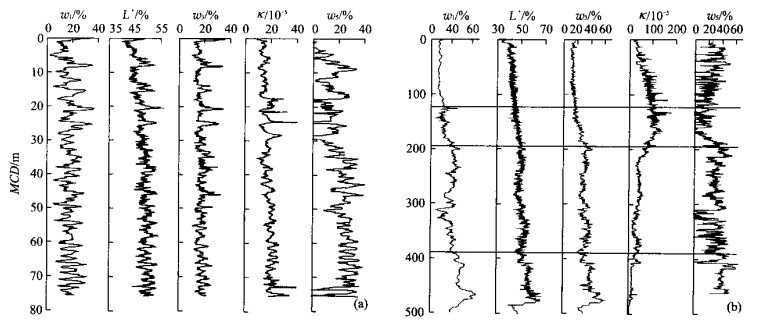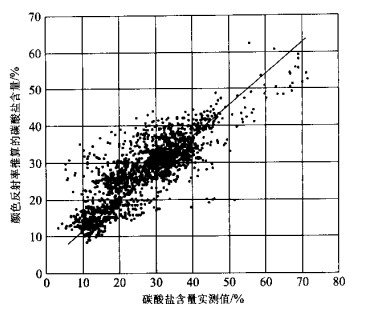Searching Physical Indicators of Carbonate Contents of Deep Sea Sediments
-
摘要: 运用岩心物理性质求取深海碳酸盐沉积的相对含量, 是古海洋学研究中一种“多快好省”的办法, 在低分辨率研究中取得成功, 但在较高分辨率的研究中精度问题十分突出. 采用大洋钻探(ODP) 184航次船上颜色反射率和磁化率数据, 结合实验室碳酸盐化学分析实测结果, 运用最小二乘法等数理分析方法, 分别建立颜色反射率和磁化率与碳酸盐含量之间的拟合方程, 估算碳酸盐含量. 结果表明, 根据颜色反射率蓝色光波段值及其平方作为控制变量来拟合的碳酸盐含量, 同实测值具有较高的一致性, 误差较小; 但是, 用磁化率推算的碳酸盐含量同实测值比较则误差相当大. 用岩心物理性质推测的拟合方程是在开展一定量实测分析的基础上建立的, 不同站位的这种拟合关系不能套用, 只有当其他影响成分含量相当稳定或有规律变化时, 运用岩心物理性质求取深海碳酸盐沉积含量的方法才具有相当高的应用价值.
-
关键词:
- 碳酸盐 /
- 颜色反射率 /
- 磁化率 /
- 南海 /
- 大洋钻探(ODP)184航次
Abstract: Physical property of deep-sea sediment core is useful to make an efficient calculation of the percent carbonate, which has been successful in low resolution research rather than in high resolution research. Multiple regression equations are generated based on the comparing diffuse reflectance and magnetic susceptibility records from ODP Leg 184 with carbonate contents measured in our laboratory. It is found that percent carbonate estimated with diffuse reflectance is closer to the measured one than that estimated with magnetic susceptibility, and the multiple regression equation varies in different sites.-
Key words:
- carbonate /
- color reflectance /
- magnetic susceptibility /
- South China Sea /
- ODP Leg 184
-
表 1 ODP 1148站通过最小二乘法拟合的c值
Table 1. Coffieteuts for the ODP site 1148

-
[1] Sundquist E T, Broecbet W S. Carbon cycle and atmospheric CO2: natural variations Archean to present [M]. Washington D C: Geophys Momogr Ser AGU, 1985. 32-627. [2] Norris R D, Röhl U. Carbon cycling and chronology of climate warming during the Palaeocene/Eocean transition [J]. Nature, 1999, 401: 775-777. doi: 10.1038/44545 [3] Curry W B, Lohmann G P. Late Quaternary carbonate sedimentation at the Sierra Leone Rise(eastern equatorial Atlantic)[J]. Mar Geol, 1986, 70: 223-250. doi: 10.1016/0025-3227(86)90004-6 [4] Andersson C. Pliocene calcium carbonate sedimentation patterns of the Ontong Java plateau: ODP sites 804 and 806[J]. Marine Geology, 1998, 150: 51-71. doi: 10.1016/S0025-3227(98)00053-X [5] Wang P, Wang L, Bain Y, et al. Late Quaternary paleoceanography of the South China Sea: surface circulation and carbonate cycles[J]. Marine Geology, 1995, 127: 145-165. doi: 10.1016/0025-3227(95)00008-M [6] Ortiz J, Mix A, Harris S, et al. Diffuse spectral reflectance as a proxy for percent carbonate content in North Atlantic sediments[J]. Paleoceanography, 1999, 14: 171 - 186. doi: 10.1029/1998PA900021 [7] Naidu P D, Malmgren B A. Quaternary carbonate record from the equatorial Indian Ocean and its relationship with productivity changes[J]. Marine Geology, 1999, 161: 49 - 62. doi: 10.1016/S0025-3227(99)00055-9 [8] Howard W R, Prell W L. Late Quaternary CaCO3 production and preservation in the southern ocean: implications for oceanic and atmospheric carbon cycling[J]. Paleoceanography, 1994, 9: 453-482. doi: 10.1029/93PA03524 [9] Schmieder F, Dobeneck T, Bleil U. The Mid-Pleistocene climate transition as documented in the deep south Atlantic Ocean: initiation, interim state and terminal event[J]. Earth and Planetary Science Letters, 2000, 179: 539-549. doi: 10.1016/S0012-821X(00)00143-6 [10] Hounslow M W, Maher B A. Source of the climate signal recorded by magnetic susceptibility variations in Indian Ocean sediments[J]. Journal of Geophysical Research, 1999, 104: 5047-5061. doi: 10.1029/1998JB900085 [11] Mix A C, Harris S E, Janecek T R, et al. Estimating lithology from nonintrusive reflectance spectral: Leg 138 [A]. In: Pisias N G, Mayer L A, Janecek I R, et al. eds. Proceedings of the ocean drilling program[C]. Scientific Results, 1995, 138: 413-427. [12] Balsam W L, Deaton B C, Damuth J E. Evaluating optical lightness as a proxy for carbonate content in marine sediment cores[J]. Marine Geology, 1999, 161: 141-153. doi: 10.1016/S0025-3227(99)00037-7 [13] Maher B A. Magnetic properties of modern soils and Quaternary loessic paleosols, paleoclimatic implications[J]. Palaeogeog Palaeoclimatol Palaeoecol, 1998, 137: 25-54. doi: 10.1016/S0031-0182(97)00103-X [14] Wang P, Warren L P, Peter B, et al. Proc ODP, Init Repts, 184[EB/CD]. Available from: Ocean Drilling Program, Texas A&M University, College Station TX 77845-9547, USA. 2000. [15] Shipboard Scientific Party. Explanatory notes[A]. In: Wang P, Warren L P, Peter Blum, et al. eds. Proc ODP, Init Repts[C]. Available from: Ocean Drilling Program, Texas A&M University, College Station TX 77845-9547, USA. 2000. 184, 1-48 [16] Frederichs T, Bleil U, D‐umler K, et al. The magnetic view on the marine paleoenvironment: parameters, techniques and potentials of rock magnetic studies as a key to paleoclimatic and paleoceanographic changes[A]. In: Fischer G, Wefer G, eds. Use of proxies in paleoceanography: examples from the south Atlantic[C]. Berlin Heidelberg: Springer-Verlag, 1999. 575-599. [17] Rühlemann C, Müller P J, Schneider R R. Organic carbon and carbonate as paleoproductivity proxies: examples from high and low productivity areas of the tropical Atlantic[A]. In: Fischer G, Wefer G, eds. Use of proxies in paleoceanography: examples from the South Atlantic [C]. Berlin Heidelberg: Springer-Verlag, 1999. 315-344. [18] Dobeneck T, Schmieder F. Using rock magnetic proxy records for orbital tuning and extended times series analyses into the super- and sub-Milankovitch bands[A]. In: Fischer G, Wefer G, et al. eds. Use of proxies in paleoceanography: examples from the South Atlantic[C]. Berlin Heidelberg: Springer-Verlag, 1999. 601-633. [19] Bloemendal J, Lamb B, King J. Paleoenvironmental implications of rock-magnetic properties of late Quaternary sediment cores from the eastern equatorial Atlantic[J]. Paleoceanography, 1988, 3(1): 61-87. doi: 10.1029/PA003i001p00061 -










 下载:
下载:


